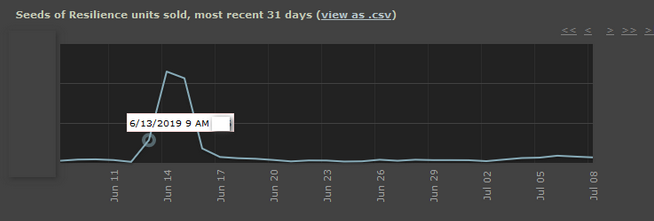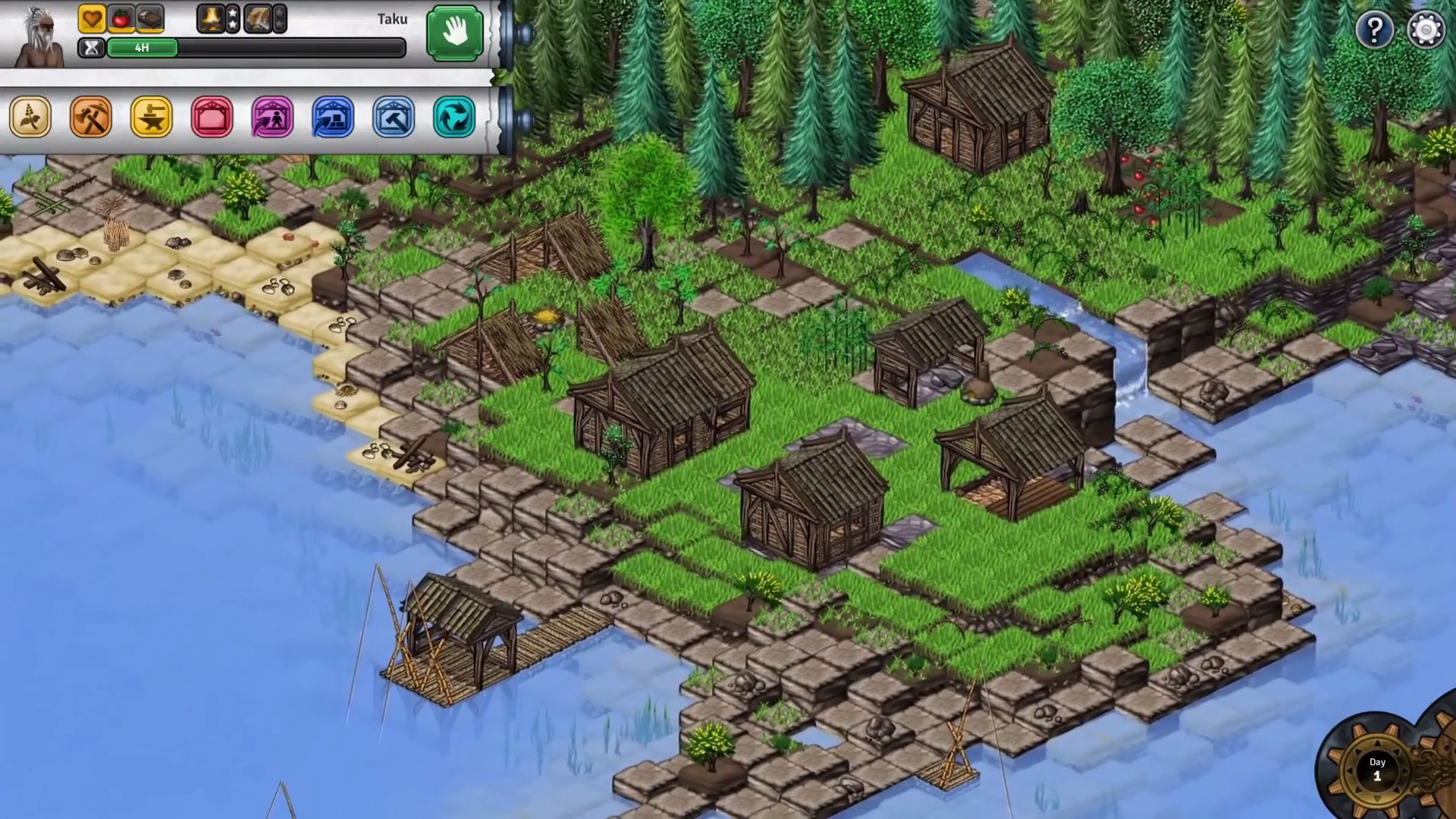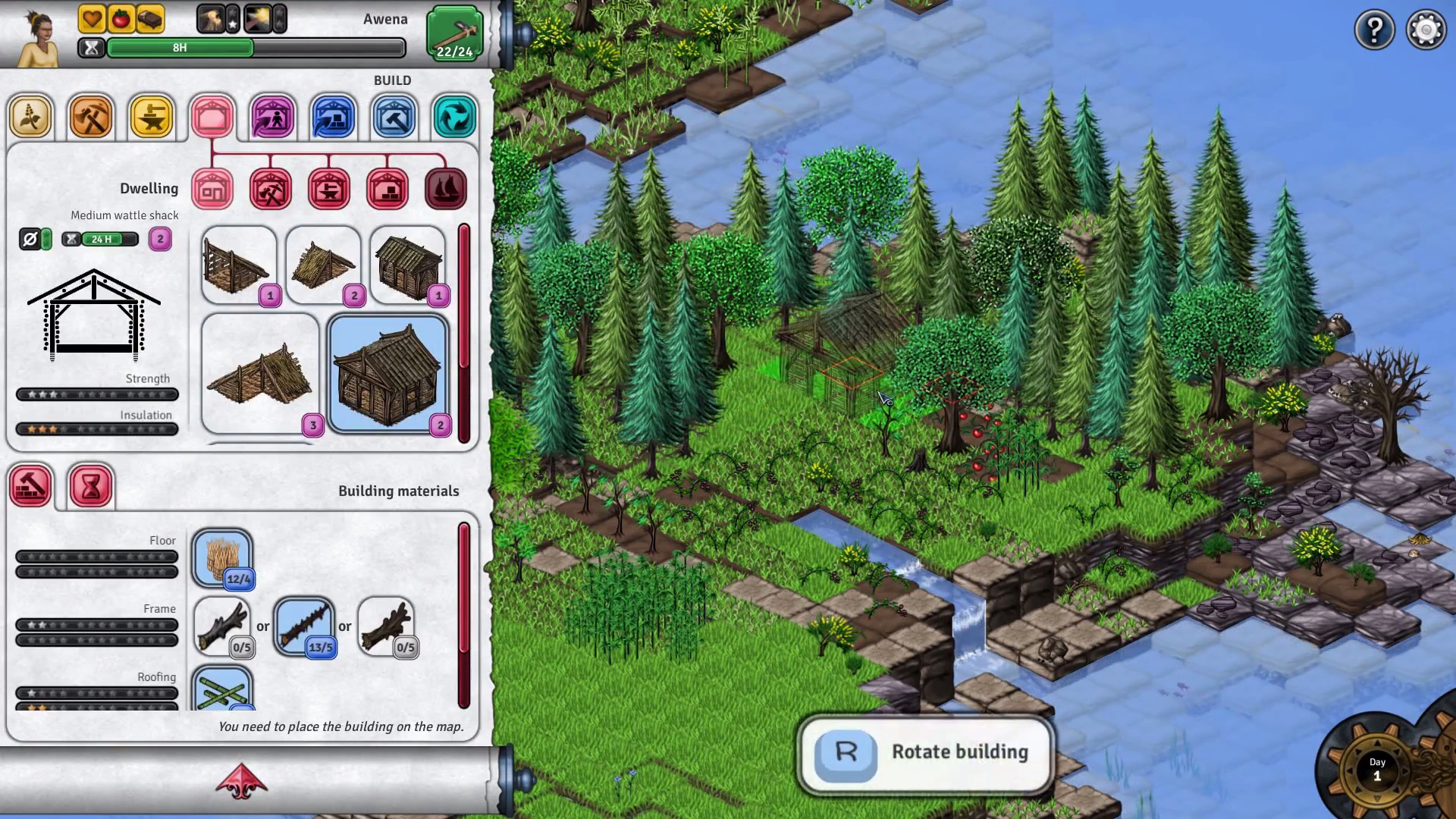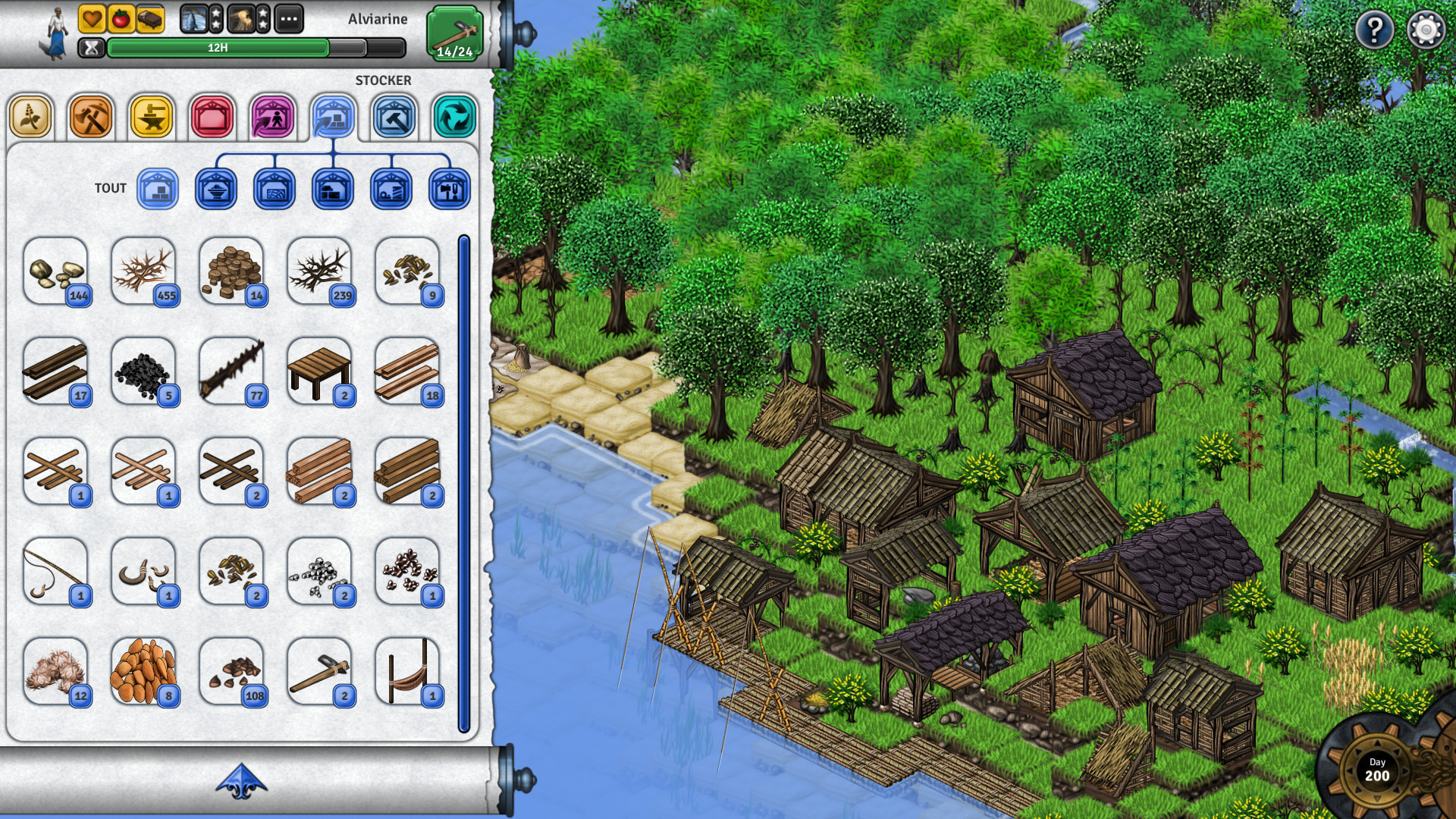The Game:
Build a village on a desert island, and prepare for merciless natural disasters! Learn to choose the right items, understand nature's behaviour and use real medieval construction and craft techniques in this turn-base management game.Features
- Patiently go through the steps of re-creating a civilization: Start with a stone axe and a shelter made out of branches to finally build elaborate houses and mechanized workshops.
- Survive in a harsh environment where storms and other natural disasters occur way too often.
- Turn based: Take all the time you need to plan your actions. When you're done, click the end turn button and start a new day.
- Detailed building construction: Choose natural resources according to their properties. Use them to craft the materials needed to assemble a building.
- Realistic medieval construction and craft techniques. Everything could be made in real life the same way.
- Observe the environment response to human activity. Maybe you should avoid fishing everyday at the same spot or cut down the whole forest.
Seeds of Resilience Postmortem
Hello everyone! Were Antonin (part of Subtle Games) & Tavrox (part of Goblinz Studio), who worked on Seeds of Resilience. The full team also includes Alexandre & other people you can find in the credits of the game.
We wanted to take some time to make a postmortem of Seeds of Resilience. After 6 years, our environment friendly village builder went through a lot of hard times. Lets dive into the history of the project.

At this time we are 4 in the team. The game we have in mind is a mix of all our ideas: A massively multiplayer browser game with RPG-like characters. You can also build villages with other players, explore a huge map. We use a home-made engine using HTML5/javascript, our team put no effort in project management, and has no game design skills. During this year, we work on our first prototype but we are amateurs. You know, the kind with big ideas way too big!

While Alexandre rework the graphics, Antonin starts learning game design by reading and experimenting. He also starts to meet other indie developers that help a lot by giving constructive feedback on different parts of the project. Its also a great boost of motivation. At the end of the year, two team members leave the project because they cant or dont want to spend enough time to make the game progress. This is a hard time and we are close to give up.

Alexandre and Antonin spend some holidays together and rethink the whole concept of the game. It helps them drop the RPG aspects and focus on village-building. Alexandre redraws everything while Antonin starts to do some serious project management. They both start searching for realistic data about medieval crafting and building techniques. At the end of the year, we have something interesting to play, though the UI is awfully unintuitive!

Antonin realizes making a home-made engine is not a good idea. We switch to Unity, work in short iterations and remake every part to make it better. We put great effort into UI improvement but our lack of skill limits us. The environment friendly appears and looks really promising.

We start working with Tavrox who handles marketing and community management. We launch the game on itch.io then on Steam Early Access. A lot of players give feedback and were more confident about the game. A few months later, we start working with Goblinz Studio. They invest in the game. With their help, we remake the whole UI for the sixth and last time. Its also at that time we get the game localized in 9 languages, add sound design and music. Finally, we released the game!
Fun fact: Until June 2018, our game is called Stormland, but a big studio announced a game with the same name. It was a bit stressful for a few days but it gave us the opportunity to find a more suiting name.

In the end, the game has a unique chill vibe. We see a lot of games with violence and killing; making a game that has none of those characteristics is very hard. It was at the core of the teams philosophy and is now a good solid point of the game. The visual arts are also very specials.. Ultimately, the sound designer brought a nice sound layer on top of all that. It doesnt have the ultimate graphics, but people like it for its simplicity.
Going through a very long development time, its hard to see the light at the end of the tunnel! Some of us have been in several game productions, and surviving through 6 years of development is hard. The 1.0 launch has been doing ok. The game is not recouped yet, but a good part of it is. In the end, the game is also timeless, it doesnt fit to a trend or anything. Its important because in the long run, it can make good sales.
The project had complete rework several times during the development, at least 3 or 4 times. As you could read in the chronology, it also meant several people worked on the game with several different art directions and game cores. 6 years for an indie project is quite unusual, what we see on average is more around 2-3 years.

Antonin sometimes felt really isolated, living in the countryside far from other developers, sometimes having contact only once a week with Alexandre (who went travelling for a year in his van). Working remotely has many benefits but after years of doing so, the lack of social contact started to be a burden.
The project was in development for a long time with very few public demo. We only showed the game in local events such as Stunfest or Utopiales. It changed when Tavrox started to work on the game marketing and we decided to launch an open alpha on Itch.io.
We also tried during the open alpha to make more community building and allow people to have a say about what will be in the next patches. For instance, we had a public trello where people could directly vote.

After a while, we met Aline and her platform Red Bricks, which looked interesting. Its a community building platform.Were glad to be the biggest project there. It is still in early development so in retrospect, it made the community building part a bit slower, but it wasnt a major issue. Also, it helped having things more streamlined.
Then, we launched on Steam and had a good first month, considering our very low marketing budget. We saw some opportunity and shared the figures with Johann (Founder & Gamedev of Goblinz Studio). He agreed to invest around 15k on the game to give it a real marketing chance. After a few months, Tavrox was hired by Goblinz Studio and Seeds of Resilience could get a good amount of marketing time and expertise. Johann did his amazing Steam marketing optimization and we got decent long-term sales during Early Access.
Every month got an update, as you can read here (link). It was very interesting to incorporate the community and be very open about the development.
Our major issue was the ping pong with Mixed reviews on Steam. During some weeks, the game would get into Mixed Reviews (<70% positives) and we had low sales. Then it would get back into Mostly Positive (>70% positive) and the sales would double or triple every day. It happened because the game is a bit special and some players that are looking for a standard, tailored experience dont always get it. Seeds is a calm, peaceful game.
With the problems around mixed reviews, the launch was a bit harsh. The game is launched on June 13th, and as you can see on this graph, the launch day wasnt the biggest of our days.

It was the few ones after, because we worked with Maple Whispering on the Chinese Marketing. They did a great job and it was definitely worth working with them! As of today 09/07/019, we have around 20% chinese players.
Overall, the reception to the 1.0 version was awesome and were glad the game is in a very good state. People like it, its not the million-dollar sellers that everyone will buy. Were in a chill nice and our players like that the game is different enough. The release feels like a moral and sales success to us.
To this day, the game has sold around 8k units on Steam + a bit on Itch.io. In the end, its hard to see if we recouped because 6 years with very flexible hours is a very long time. But the game is now out and solid, ready to play for years to come!

Antonin is taking some rest from the development of the game. Were not sure about what we will be adding or fixing within the next months or years. There might be nothing, there might be something, just dont expect anything.
We are discussing with people about price of ports for consoles, but its interface is heavy so it might be tricky to do. Of course, if there are critical bugs that prevent players from playing on Steam, we will look into them.
Thank you for reading, we wish you the best.
Cheers,
Subtle Games & Goblinz Studio.
Postmortem
Hello everyone! Were Antonin (part of Subtle Games) & Tavrox (part of Goblinz Studio), who worked on Seeds of Resilience. The full team also includes Alexandre & other people you can find in the credits of the game.
We wanted to take some time to make a postmortem of Seeds of Resilience. After 6 years, our environment friendly village builder went through a lot of hard times. Lets dive into the history of the project.
Project History : 6 years of labor

Year 1
At this time we are 4 in the team. The game we have in mind is a mix of all our ideas: A massively multiplayer browser game with RPG-like characters. You can also build villages with other players, explore a huge map. We use a home-made engine using HTML5/javascript, our team put no effort in project management, and has no game design skills. During this year, we work on our first prototype but we are amateurs. You know, the kind with big ideas way too big!

Year 2
While Alexandre rework the graphics, Antonin starts learning game design by reading and experimenting. He also starts to meet other indie developers that help a lot by giving constructive feedback on different parts of the project. Its also a great boost of motivation. At the end of the year, two team members leave the project because they cant or dont want to spend enough time to make the game progress. This is a hard time and we are close to give up.

Year 3
Alexandre and Antonin spend some holidays together and rethink the whole concept of the game. It helps them drop the RPG aspects and focus on village-building. Alexandre redraws everything while Antonin starts to do some serious project management. They both start searching for realistic data about medieval crafting and building techniques. At the end of the year, we have something interesting to play, though the UI is awfully unintuitive!

Years 4 and 5
Antonin realizes making a home-made engine is not a good idea. We switch to Unity, work in short iterations and remake every part to make it better. We put great effort into UI improvement but our lack of skill limits us. The environment friendly appears and looks really promising.

Year 6
We start working with Tavrox who handles marketing and community management. We launch the game on itch.io then on Steam Early Access. A lot of players give feedback and were more confident about the game. A few months later, we start working with Goblinz Studio. They invest in the game. With their help, we remake the whole UI for the sixth and last time. Its also at that time we get the game localized in 9 languages, add sound design and music. Finally, we released the game!
Fun fact: Until June 2018, our game is called Stormland, but a big studio announced a game with the same name. It was a bit stressful for a few days but it gave us the opportunity to find a more suiting name.
What went right
Game mood & art direction

In the end, the game has a unique chill vibe. We see a lot of games with violence and killing; making a game that has none of those characteristics is very hard. It was at the core of the teams philosophy and is now a good solid point of the game. The visual arts are also very specials.. Ultimately, the sound designer brought a nice sound layer on top of all that. It doesnt have the ultimate graphics, but people like it for its simplicity.
Finally released & good sales!
Going through a very long development time, its hard to see the light at the end of the tunnel! Some of us have been in several game productions, and surviving through 6 years of development is hard. The 1.0 launch has been doing ok. The game is not recouped yet, but a good part of it is. In the end, the game is also timeless, it doesnt fit to a trend or anything. Its important because in the long run, it can make good sales.
What went wrong
Very long development time
The project had complete rework several times during the development, at least 3 or 4 times. As you could read in the chronology, it also meant several people worked on the game with several different art directions and game cores. 6 years for an indie project is quite unusual, what we see on average is more around 2-3 years.

Sole developer isolated
Antonin sometimes felt really isolated, living in the countryside far from other developers, sometimes having contact only once a week with Alexandre (who went travelling for a year in his van). Working remotely has many benefits but after years of doing so, the lack of social contact started to be a burden.
Marketing & sales overview
The project was in development for a long time with very few public demo. We only showed the game in local events such as Stunfest or Utopiales. It changed when Tavrox started to work on the game marketing and we decided to launch an open alpha on Itch.io.
Open Alpha
We also tried during the open alpha to make more community building and allow people to have a say about what will be in the next patches. For instance, we had a public trello where people could directly vote.

After a while, we met Aline and her platform Red Bricks, which looked interesting. Its a community building platform.Were glad to be the biggest project there. It is still in early development so in retrospect, it made the community building part a bit slower, but it wasnt a major issue. Also, it helped having things more streamlined.
Steam Early Access
Then, we launched on Steam and had a good first month, considering our very low marketing budget. We saw some opportunity and shared the figures with Johann (Founder & Gamedev of Goblinz Studio). He agreed to invest around 15k on the game to give it a real marketing chance. After a few months, Tavrox was hired by Goblinz Studio and Seeds of Resilience could get a good amount of marketing time and expertise. Johann did his amazing Steam marketing optimization and we got decent long-term sales during Early Access.
Every month got an update, as you can read here (link). It was very interesting to incorporate the community and be very open about the development.
Our major issue was the ping pong with Mixed reviews on Steam. During some weeks, the game would get into Mixed Reviews (<70% positives) and we had low sales. Then it would get back into Mostly Positive (>70% positive) and the sales would double or triple every day. It happened because the game is a bit special and some players that are looking for a standard, tailored experience dont always get it. Seeds is a calm, peaceful game.
Steam Launch : Praise for Chinese Players!
With the problems around mixed reviews, the launch was a bit harsh. The game is launched on June 13th, and as you can see on this graph, the launch day wasnt the biggest of our days.

It was the few ones after, because we worked with Maple Whispering on the Chinese Marketing. They did a great job and it was definitely worth working with them! As of today 09/07/019, we have around 20% chinese players.
Overall, the reception to the 1.0 version was awesome and were glad the game is in a very good state. People like it, its not the million-dollar sellers that everyone will buy. Were in a chill nice and our players like that the game is different enough. The release feels like a moral and sales success to us.
To this day, the game has sold around 8k units on Steam + a bit on Itch.io. In the end, its hard to see if we recouped because 6 years with very flexible hours is a very long time. But the game is now out and solid, ready to play for years to come!

What about the future?
Antonin is taking some rest from the development of the game. Were not sure about what we will be adding or fixing within the next months or years. There might be nothing, there might be something, just dont expect anything.
We are discussing with people about price of ports for consoles, but its interface is heavy so it might be tricky to do. Of course, if there are critical bugs that prevent players from playing on Steam, we will look into them.
Thank you for reading, we wish you the best.
Cheers,
Subtle Games & Goblinz Studio.
[ 2019-09-24 12:55:34 CET ] [Original Post]
Minimum Setup
- OS: Any
- Processor: Intel core 2 duoMemory: 2 GB RAM
- Memory: 2 GB RAM
- Graphics: Intel HD Graphics 5500
- Storage: 200 MB available space
Recommended Setup
- OS: Any
- Processor: Intel core i3-500 or betterMemory: 4 GB RAM
- Graphics: NVIDIA GeForce GTX 2 Go
- Storage: 200 MB available space
GAMEBILLET
[ 6530 ]
GAMERSGATE
[ 1729 ]
MacGamestore
[ 4683 ]
FANATICAL BUNDLES
HUMBLE BUNDLES
by buying games/dlcs from affiliate links you are supporting tuxDB







































